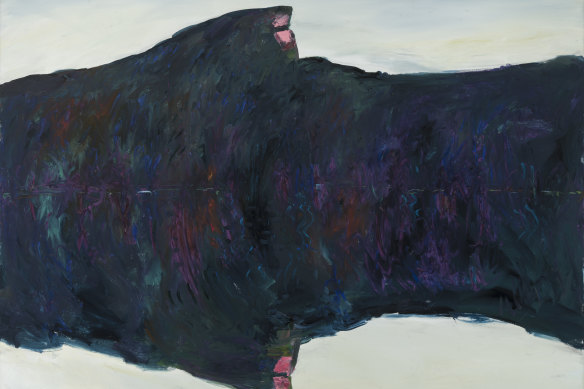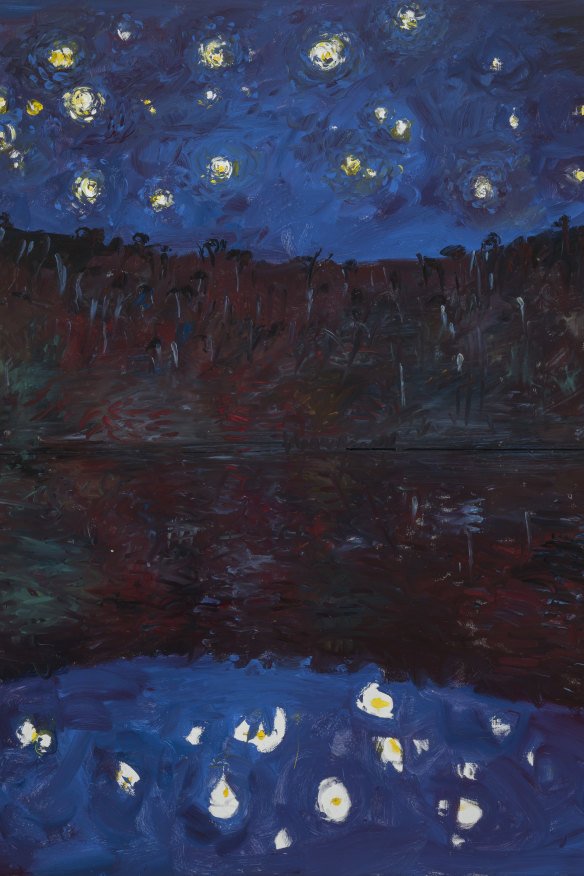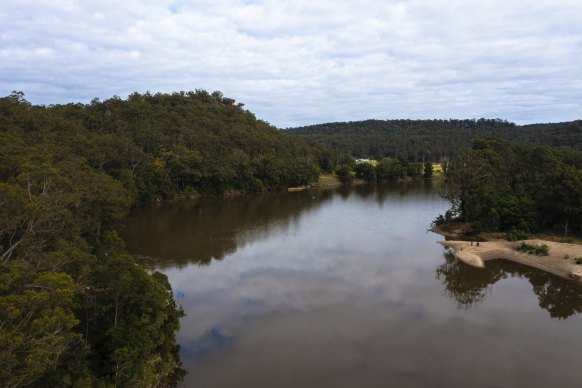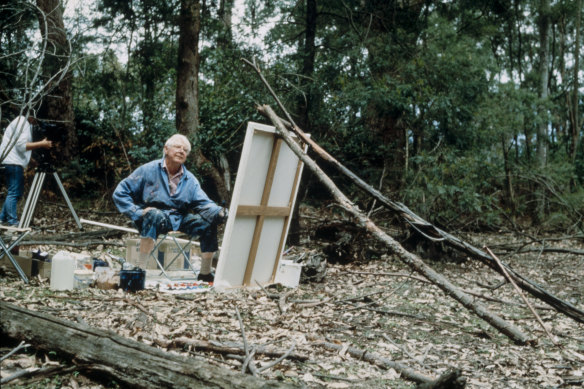In July 1983, Arthur Boyd received the kind of commission that artists both dream about and dread: to create two large paintings and a suite of smaller works for the new Arts Centre Melbourne. It was a rare privilege to have one’s pictures on permanent display in the halls and foyers of a major public building, but the job had a fearsome deadline, with a grand opening set for October 1984.
Of all Australian artists, with the possible exception of his brother-in-law, Sidney Nolan, Boyd was the best equipped for the task. By this stage, Arthur and his family had settled at their property on the Shoalhaven, where, in the words of Sophie O’Brien, co-curator of the Bundanon exhibition, Wilder Times: Arthur Boyd and the mid-1980s landscape, “he had to plan for a substantial level of creative output.” In other words, to pay for Bundanon, Boyd was churning out Shoalhaven landscapes for a ready market.

Arthur Boyd’s Early Light – Pulpit Rock (1984).
This brings us to one of the great internal tensions in Boyd’s career – between the lyrical landscapes adored by the public, and the visionary works that were hugely significant to the artist but held little appeal for buyers. It was one long arm-wrestle between art and commerce, in which Boyd strove to maintain his artistic integrity without compromising sales.
The Arts Centre commission, arranged by designer John Truscott, was originally viewed as an opportunity to paint ambitious allegorical subjects. This scheme was realised in the two large works, Landscape with Dog and The Actor, not included in the Bundanon exhibition. The rest of the commission, which began as a request for nine paintings but soon grew to 14, would focus on landscape.

Arthur Boyd’s Starry Night – Shoalhaven River (1984).
What’s most significant about this series of Shoalhaven pictures is that they are conceived as a distinct cycle starting with a van Gogh-like Starry Night and proceeding through different times of day and weather conditions, to capture the moods of the landscape reflected in the river. One thinks of Claude Monet’s cycles of haystacks or the facade of Rouen Cathedral, which must have featured in Boyd’s imaginings.
For Arts Centre curator Steve Tonkin the thrill of the Bundanon show is that this is the first time the entire suite has been displayed in a conventional gallery space. For Bundanon, it was a unique opportunity to show an important collection of Boyd’s works in the place they were made. Viewers may leave the gallery and walk to the banks of the river, comparing the artist’s efforts with those of Mother Nature.
Although Boyd was prone to repetition, these paintings are notable for their inventiveness and variety. Unlike so many Shoalhaven landscapes, considerable time and effort went into the series, allowing for the speed with which Boyd was obliged to work. The simplest and brightest painting is Midday, presented as the last in the group. The most purely atmospheric is Shoalhaven River Bank with Star and Black Swan, a nocturnal scene in sumptuous tones of blue and purple, balanced by the glow of a green willow. Given the countless biblical references in Boyd’s work, it’s not outrageous to read the lone star in the sky as the Star of Bethlehem, transplanted to God’s own country in southern NSW.

The location on the Shoalhaven River where Arthur Boyd painted his landscapes.Credit: Rhett Wyman
Boyd had favourite symbols and motifs that recur from one canvas to the next. There’s a willow, the black swan, a black cockatoo, and the looming silhouette of Pulpit Rock, which provided his version of Cézanne’s romance with Mont Sainte-Victoire. We can craft ingenious interpretations for these images, or simply accept them as intrinsic to the landscape. The menacing shape of a black storm cloud in Dark Cloud – Shoalhaven River hints at the disaster that threatens if we disrespect the environment, a constant preoccupation for the artist. I thought of John Ruskin’s ominous warnings in his 1884 lecture, The Storm Cloud of the Nineteenth Century.
Looking closely at these pictures one can see how Boyd would apply the paint quickly in a central band, allowing colours to run together and grow murky. He would overcome dullness by using small dabs of colour to animate a patch of deep shadow. From a distance, this works well, although there’s a sense of barely contained chaos on nearer approach. It could be argued this is the way we read the landscape itself.

Arthur Boyd’s Shoalhaven River and Black Swan (1984).
The second part of this exhibition features an eclectic, original selection of works made by other Australian artists in the early 1980s. An obvious stand-out is Imants Tillers’ Pataphysical Man (1984), from the Art Gallery of NSW collection, which combines a figure by Giorgio de Chirico with images from Latvian children’s books and handprints from cave walls. It’s an icon of the “appropriation” aesthetic.
There’s also Naples Green (1985), an impressive abstract painting by John Peart, imbued with the unmistakable essence of the Australian bush, and three ochre paintings by Rover Joolama Thomas, depicting sites of historic massacres using a traditional visual language that appears abstract to those uninitiated into its mysteries.
The Peart and Thomas paintings are drawn from the collection of Janet Holmes à Court, one of many Western Australian connections in this show. The choices reflect a personal preference on behalf of Sophie O’Brien, who grew up in Perth surrounded by important artists who were virtually unknown on the East Coast. The greatest of them was Howard Taylor, represented by two exquisite, minimal landscapes, but there are also pieces by Mac Betts, Brian Blanchflower, and Richard Woldendorp, celebrated for his aerial photography.

Arthur Boyd at Bundanon.Credit: Bundanon Archive
It was a surprise and a pleasure to see these works because the neglect of Western Australian artists is a historical wrong that public art museums have yet to rectify. O’Brien’s other selections are just as idiosyncratic, including artists as diverse as David Aspden, Bonita Ely, Tim Johnson, Robert MacPherson, Vivienne Binns, Liz Coats, Mike Brown, Susan Norrie, Robert Jacks, Gerrit Fokkema and Judy Cassab. There are political posters by Bob Clutterbuck and Toni Robertson, and a painting by Timmy Payangu Tjapangati from the all-important Papunya Tula movement.
There are also experimental movies by Arthur and Corinne Cantrill, Keith Gow’s 1984 documentary on the women of Utopia, and Helen Grace’s short, droll film Serious Undertakings (1982) which captures the aura of high seriousness with which intellectuals – chiefly male – discussed art, feminism and politics in the early 1980s. The saving grace, if you’ll pardon the pun, is the filmmaker’s air of scepticism and satire, which never quite allows us to take this blather at face value.
Were the early 1980s really the “wilder times” claimed by the title? There was nothing wild about the solemn intellectualising that went on at art events, or the facile games played by self-conscious postmodernists. Bob Hawke became prime minister on March 11, 1983 and brought in a range of sweeping reforms – back in the days when “reforms” didn’t mean simply slashing public services. Hawke, with his 75 per cent popularity rating, was certainly a wilder proposition than Albanese, but the world today may be on the verge of a wildness undreamt of in 1983.
This was the era when Aboriginal art began to emerge as a force, but there was no hint of the million-dollar price tags commanded by the major artists today or that an Aboriginal “nation” would be assigned every work of Australian art. It was a time when gender equality made huge strides, but no-one thought we’d have to declare our pronouns every time we sign our name. It may be more accurate to think of the early 1980s as an Age of Reform, and anticipate – not without anxiety – that the wilder times are on the way.
Wilder Times: Arthur Boyd and the mid-1980s landscape is at the Bundanon Art Museum until October 13. John McDonald was a guest of Bundanon.
The Booklist is a weekly newsletter for book lovers from books editor Jason Steger. Get it delivered every Friday.